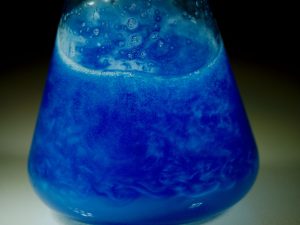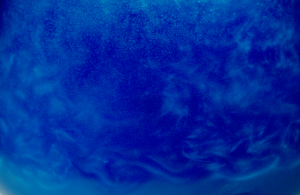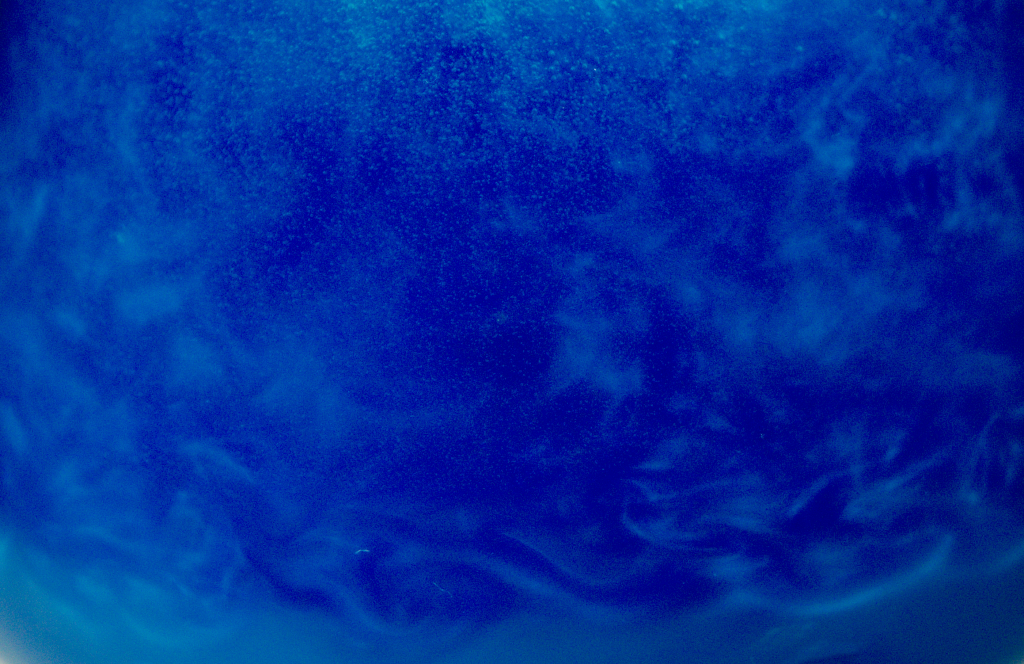First Team Photo
Greg Collins
10/09/2018
Initially I wanted to take a photo of a Nicola Tesla one-way valve, particularly the turbulence of the backward directed flow where there would be the greatest impedance to the flow. To see the turbulence, I made rheoscopic fluid following the directions from the paper “Rheoscopic Fluids in a Post-Kalliroscope World”. I hoped that the rheoscopic fluid, which is good at refracting light in turbulent flow, would show a nice pearlescent knot at the juncture. However this did not work out, and I was unable to see the effects of the rheoscopic fluid through the valve. This failure might have been due to how thin the rheoscopic fluid was inside the valve, or perhaps the lighting was not right for the set up I had. I did find when playing with the fluid in a clear vessel beautiful swirl patterns were forming. I decided to use this phenomenon for my photo as it clearly showed the effects of no slip conditions on a surface. With the help of Duncan Lowery, Brent Eckles and Bradley Busek I was a able to get a good photo from our experiment.
I made the rheoscopic fluid, following the directions of “Rheoscopic Fluids in a Post-Kalliroscope World”. I used Barbasol shaving cream like suggested. I filled a milk jug with the shaving cream, then filled the jug with ¾ water. I capped the jug and shook it. Next I allowed it to settle for about 20 minutes. After it had settled I siphoned off the fluid in the bottom while taking care not to get any of the sediment on the bottom or the foam on top. Finally, I poured the liquid incrementally through paper coffee filters to help with the cloudiness. (Borrero-Echeverry)
The experiment consisted of a beaker filled with the rheoscopic fluid mixed with 6 drops of blue dye. The beaker then was placed on a diffuse white table while Bradley Busek, Brent Eckles, and I held the two LED lights about 120 degrees off the angle of the camera. Duncan Lowery operated the camera and took photos and videos. To agitate the fluid, we gave a quick twist to the beaker, which caused the wave pattern seen in the photo.
The wave pattern shows the no slip condition near a boundary of a surface. The no slip condition is when the fluid velocity is the same as the boundary velocity. The condition is generally applied to most viscous systems but there may be conditions and fluid where this does not apply. The other phenomenon seen is shearing. Shearing in fluid is most commonly seen as a shear stress. . Where is the dynamic viscosity, u is the flow velocity and y is the boundary layer. What this means for the for the experiment is when the beaker twists it is moving parallel to the fluid at some velocity u, and because of the no-slip boundary condition the fluid immediately around the surface of the beaker moves with the same velocity as the beaker. Now that a small amount fluid is moving at the same speed as the beaker, the fluid will impart a shear on the neighboring layer above it. This new layer will not be going as fast because it will shear, or in other words, slip. This will continue layer by layer until there is no significant velocity to impart. For this photo the beaker was twisted rapidly 180 degrees forward and back then stopped. This motion causes the fluid to flow in one direction. Then when the beaker went the other direction the no slip condition forced the fluid next to the walls to go the other direction, causing the fluid to shear across its self. This made the eddy waves seen in the photo. (No-Slip Condition) (Shear Stress)
To see this fluid phenomenon I used rheoscopic fluid. “Rheoscopic fluids are a common technique for visualizing spatially extended flow structures. In rheoscopic flow visualization, the working fluid is seeded with small, anisotropic, reflective particles. Due to their anisotropy, the particles become preferentially aligned in the flow. Therefore, when they scatter light, they highlight qualitatively different regions of the flow.” (Borrero-Echeverry) In this case stearic acid crystals are what is used to be the anisotropic, reflective particles.
The photo was taken with a mirrorless Panasonic G85 at 16MP, with a F stop of F/5.6, a shutter speed of 1/800 s and an ISO of 640. The photo was taken with a Telephoto lens with a focal length of 150mm. I used a telephoto lens because it was easier to be farther away and to be able to move around the table the experiment was set up on. It also helped avoid accidents with water and the camera. The raw photo is 4816 x 3465 pixels. I used Gimp and Darktable to edit the photo.


In the editing process I lightly adjusted the curve. This helped to darken the blues to make it a deeper blue and it also help make the crystals in the rheoscopic fluid pop.
I think this photo clearly demonstrates the effects of no slip conditions. It would have been a better picture if the rheoscopic fluid was more reflective with a stronger contrast of dark to light. The image would also be clearer if there weren’t any bubbles, and might have been improved with better lighting. It would have been an easier image to take if I had a light diffuser and brighter sources of light. If I did this experiment again I would attempt to filter the Rheoscopic fluid a few times to see if some of the cloudiness could be mitigated or attempt to concentrate the crystals through as evaporation.
Works Cited
Borrero-Echeverry, Daniel, et al. “Rheoscopic Fluids in a Post-Kalliroscope World.” Physics of Fluids, vol. 30, no. 8, 2018, p. 087103., doi:10.1063/1.5045053.
“EngArc – L – No-Slip Condition.” EngArc – L – True Stress, True Strain, Engineering Stress, and Engineerin Strain, www.engineeringarchives.com/les_fm_noslip.html.
“No-Slip Condition.” Wikipedia, Wikimedia Foundation, 26 Aug. 2018, en.wikipedia.org/wiki/No-slip_condition.
“Shear Stress.” Wikipedia, Wikimedia Foundation, 18 Aug. 2018, en.wikipedia.org/wiki/Shear_stress.


23 Comments. Leave new
The repetition of the flow and waves on the bottom is quite eye catching. I think it was a great choice to zoom in on the photo.
I love the experimental set up, but I am having a hard time viewing the flow phenomena. It does however give me ocean vibes with deep seas and blue horizons beneath.
The process you guys did is really intense, I think with the context of the videos this image makes a lot more sense. This material is super crazy and is cool that you were able to create it and capture an image
Swirls generated a mysterious image. The top bubbles are captured in a vivid and sharp way. The contrast in the image perhaps can be improved
This is a very interesting way to show the fluid motion within the flask. The deep blue color combined with the lighter shades looks great too.
I really like the color and focus of this image. It’s pretty abstract in some ways, yet has a very clear intent. It’s a little difficult to understand the flow behind this image, and I look forward to hearing more about it. It has a certain beauty of clouds in the sky.
This is a cool shot. It kind of looks like clouds dispensing and it’s interesting to see the motion of the fluid at the bottom of this image
It’s hard to tell what the flow in this photo is. Not quite sure what’s going on. I love the colors and the gradients in the photo. It is a little grainy so maybe not cropping it quite as much and have better lighting. It’s an interesting photo though and it reminds me of a lot of modern paintings.
Cool picture. Great explanation of what’s going on. I like the saturation of the image, the bubbles are really interesting.
Pretty neat visualization technique here, I quite like that the longer you look at the image, the more detail you can start to see.
The image looks great, especially the wide frame. I like the different layer (focus area and blur area). The color contrast between white and blue is nice.
I love the happy feeling of this image. The shot has a nice texture, although it could be more in focus. Try cropping the lower two corners out as they are slightly distracting. Where you using a wide angle lens?
I do really like this image, but if it’s what I’m thinking of, it would’ve awesome to see a video. It’s a really nice color, and certain parts of it look like they’d be interchangeable with the daytime sky.
I particularly like the bottom of the image where the wave-like flow is occurring. Have you considered bringing up the contrast and brightening the image so as to bring out the details more?
this image is cool because it reminds me of clouds in the sky. the use of the blue crystal is very aqua like and I like the effect.
This is cool, though I don’t really know what is going on right off the bat. It makes you look at the photo and study it rather than a quick understanding, which is interesting.
I really like how abstract this image is. At first before the description I wasn’t sure what I was looking at, which leaves it up to the viewer to interperete what this image is.
Very interesting visualization of eddy flows. How did you get the blue coloring? It looks almost like a cloudy night just before dark.
Really like the abstract flow to this image. Almost looks like a grainy image of the sky and the blues are very appealing to look at.
Perhaps you could edit to make the flow more clear, since most of the frame is one color. However, there isn’t anything distracting in the image which is nice
Like that the vivid color takes up the whole image, and it appears more as art than an experiment. Reminds me of the vastness of the ocean.
I really like that you decided to have the subject of the image take over the whole frame. This decision removes any possibility of distracting details within the image and brings out some awesome detail. Nice focus on the fluid and bubbles!
This photo is well focused, and the subject occupies the entire frame. Lots of detail coming through. I appreciate the high shutter speed, the bubbles on the top and eddies at the bottom are very crisp considering the liquid was swirling around quickly at the time. I like how deep the shade of blue is, and with he shape of the bottom of the flask in the edge of frame, it almost looks like the surface of a planet.